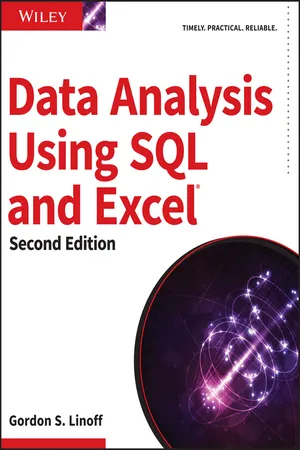
- English
- ePUB (mobile friendly)
- Available on iOS & Android
Data Analysis Using SQL and Excel
About this book
A practical guide to data mining using SQL and Excel
Data Analysis Using SQL and Excel, 2nd Edition shows you how to leverage the two most popular tools for data query and analysis—SQL and Excel—to perform sophisticated data analysis without the need for complex and expensive data mining tools. Written by a leading expert on business data mining, this book shows you how to extract useful business information from relational databases. You'll learn the fundamental techniques before moving into the "where" and "why" of each analysis, and then learn how to design and perform these analyses using SQL and Excel. Examples include SQL and Excel code, and the appendix shows how non-standard constructs are implemented in other major databases, including Oracle and IBM DB2/UDB. The companion website includes datasets and Excel spreadsheets, and the book provides hints, warnings, and technical asides to help you every step of the way.
Data Analysis Using SQL and Excel, 2nd Edition shows you how to perform a wide range of sophisticated analyses using these simple tools, sparing you the significant expense of proprietary data mining tools like SAS.
- Understand core analytic techniques that work with SQL and Excel
- Ensure your analytic approach gets you the results you need
- Design and perform your analysis using SQL and Excel
Data Analysis Using SQL and Excel, 2nd Edition shows you how to best use the tools you already know to achieve expert results.
Frequently asked questions
- Essential is ideal for learners and professionals who enjoy exploring a wide range of subjects. Access the Essential Library with 800,000+ trusted titles and best-sellers across business, personal growth, and the humanities. Includes unlimited reading time and Standard Read Aloud voice.
- Complete: Perfect for advanced learners and researchers needing full, unrestricted access. Unlock 1.4M+ books across hundreds of subjects, including academic and specialized titles. The Complete Plan also includes advanced features like Premium Read Aloud and Research Assistant.
Please note we cannot support devices running on iOS 13 and Android 7 or earlier. Learn more about using the app.
Information
CHAPTER 1
A Data Miner Looks at SQL
Databases, SQL, and Big Data
- A mature and standardized language for accessing data
- Multiple vendors, including open source
- Scalability over a very broad range of hardware
- A non-programming interface for data manipulations
What Is Big Data?
Table of contents
- Cover
- Title Page
- Copyright
- Dedication
- About the Author
- Credits
- Acknowledgments
- Foreword
- Introduction
- Chapter 1: A Data Miner Looks at SQL
- Chapter 2: What’s in a Table? Getting Started with Data Exploration
- Chapter 3: How Different Is Different?
- Chapter 4: Where Is It All Happening? Location, Location, Location
- Chapter 5: It’s a Matter of Time
- Chapter 6: How Long Will Customers Last? Survival Analysis to Understand Customers and Their Value
- Chapter 7: Factors Affecting Survival: The What and Why of Customer Tenure
- Chapter 8: Customer Purchases and Other Repeated Events
- Chapter 9: What’s in a Shopping Cart? Market Basket Analysis
- Chapter 10: Association Rules and Beyond
- Chapter 11: Data Mining Models in SQL
- Chapter 12: The Best-Fit Line: Linear Regression Models
- Chapter 13: Building Customer Signatures for Further Analysis
- Chapter 14: Performance Is the Issue: Using SQL Effectively
- Appendix Equivalent Constructs Among Databases
- EULA